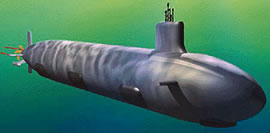Submarine Sonar And Whales

Wednesday - August 08, 2007
| Share
 Del.icio.us
Del.icio.us

|
This save-the-whales and stop-the-sonar dispute has become so bombastic that few average people can form a rational opinion.
I’m going to shred some of the secrecy curtain while also torpedoing some of the anti-sonar rhetoric.
The October 2003 issue of New Scientist shouted that “whales blasted by military sonar signals appear to die of symptoms similar to the bends.” Oops. Three years later, New Scientist said, “we cannot assign a causal relationship between the use of sonar and the deaths.”
Most of you come down on the side of your emotional sensations. If you hate to see animals killed for most any reason, you’ll side with Save The Whales Again, which claims that sonar’s the killer. If you’re attuned to our military needs, you’ll say we don’t know and that the potential death of a few whales is an OK price to pay for our species doing self-preservation.
Everyone (yes, the Navy, too) agrees that certain levels of sonar decibels may interfere with the acoustic systems of whales.
Nobody’s sure about what levels or what causes disorientation or death. But after that, the anti-sonar activists go tangential and claim that the Navy doesn’t need active-pinging radar.
That’s simply wrong.
Let me lay out some facts you may not have heard before. I’ve mined all this from research papers.
Passive listening by our newest submarines is good but not perfect.
The detection distance against very quiet targets where background noise is high is so small that the sub usually only can find that target when it runs into it. In shallow water with a complex bottom, detection range with passive sonar against a quiet target drops to few kilometers even with the best weather conditions.
The Navy does use passive (listening) sonar for tailing another sub or keeping its presence totally secret. It can detect fairly loud ships thousands of kilometers away.
But the sub will only know the general location of something - no torpedo targeting information. To target long distance, you must actively ping. The wide-band, low-energy sound that may interfere with whales is also the one that can be used without giving away much of your own location.
The Navy has been trying to limit active sonar tests in areas known to have whale pods.
Can they detect them all? No - not outside the roughly 20,000-yard passive-listening system for things of under 15,000 cycles per second used by our Los Angeles and Seawolf class of submarines.
The only issue I see is about large-scale warfare exercises with low- to mid-range frequency pinging in shallow waters during the whale mating, birthing and calf-tending period. Whales tend to inhabit the same-depth waters that are critical for Pacific Submarine boats to use for practice with measuring hydrophones to detect submarines not giving off the familiar signatures of a modern nuclear boat.
And the key Navy argument continues to be that the passive sonar called the towed array, a line of transducers trailed astern, can detect distant targets but cannot provide range and bearing data that are sufficient for firing torpedoes.
Some active sonar training must be done in waters around Hawaii before our Pearl Harbor subs go on patrols. And we’ve got whales around here part of every year.
What gets priority? That’s a legitimate political argument.
But it should not be sidetracked by misinformed arguments that the Navy no longer needs active, low-range sonar.
That’s wrong and should be discarded from the discussion.
I suppose some editorial writer’s wrongheaded gush of compassion led to a daily newspaper’s recommendation that Japanese citizen Ayato Endo, convicted of the felony sex assault on a 6-year-old girl, be allowed to keep cutting hair at Thom’s Barber Shop at Ala Moana Center because he hasn’t hit on another kid for 23 years.
The writer said: “Endo deserves a break from deportation.”
Let’s be rational. Endo avoided deportation in 1984 only by a slip-up. Then he lied and claimed he is a U.S. citizen. He is not. He’s a foreign sex offender.
Keep front-of-mind that his victim was a 6-year-old girl. Endo was 38 at the time. The offense happened here.
I cannot imagine how any reasonable editorialist can find that Endo deserves a break just because he hasn’t raped any kids in the past 23 years and is a great haircutter at Thom’s, and you know I’m a bleeding heart.
E-mail this story | Print this page | Comments (0) | Archive | RSS Comments (0) |
Most Recent Comment(s):













